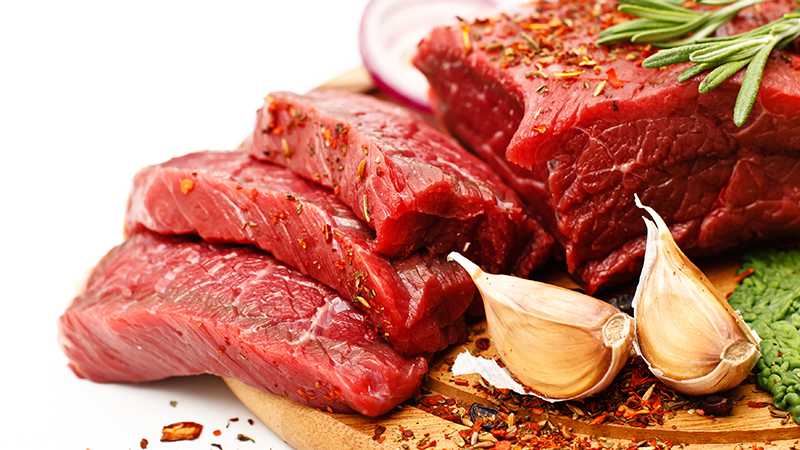
The surprising truth about which animal foods enhance health and which you should avoid.
Throughout the process of evolution, humans not only relied on animal organs and muscle meats for survival, these foods also fueled the development of our amazing brains to give us capabilities beyond those of other creatures.
Animal foods provide a complete protein with all amino acids, along and many other vital nutrients, making building a better brain and body easier at any age.
Many of the bad things you’ve heard about meat may be true. Most meats are to be avoided because they’re highly processed, or come from animals fed unhealthy food and chemicals, and treated inhumanely.
Emotions aside, healthy sources of meat fortunately are easier to obtain these days, thanks to various quality standards. However, the best source remains finding a local family farm where you can ask about how the animals are raised. In particular, look for those raised without chemicals, grass-fed without corn, and humanely treated from start to finish.
Terms like organic, kosher, and other standards may be important too, but many small family farms can’t afford the high costs of organic or other certifications, even though their standards may be higher than those required by governmental agencies.
And let me be clear that I’m not talking about overeating meat, but rather making it part of healthy dietary choices, which includes vegetables, nuts, seeds, fruits and other natural foods.
You also may notice that turkey, lamb, and farm-raised “wild” animals like bison, elk and venison didn’t make my list. That’s because they fall somewhere in between. I do like lamb on occasion, especially rare, but rarely eat turkey. In addition, I find many cuts of some meats to be too low in fat, although a great sauce can solve that issue.
Worst Meats
1. Processed and fast foods. Topping the list of meats to avoid are those that are highly processed. This includes most lunch meats, prepared and fast foods, and ground meats, and makes up the majority of meat sources in the marketplace. This is also the reason many studies show negative effects of meat-eating — most of the meat eaten by study subjects is highly processed. Lunch meats and other prepared foods, like fast-food or prepackaged burgers and sausages are usually full of added chemicals and sugar (and flour) as fillers. One just has to read the ingredients in a typical deli ham, salami, baloney or other loaf or prepared meat products. This includes organ meats, normally the most nutritious. Liverwurst may be worst due to it being a processed meat made from the organ that filters toxins from the body.
2. Chicken. Ah, the old so-called healthy meat (as if “white” somehow means “good”). Standards for raising and slaughtering chickens are much lower than any other meats. More importantly, chicken contains the highest levels of arachidonic acid of all meats — this fat easily converts to inflammatory chemicals (the eicosanoids).
3. Fish. One of the common recommendations is to eat at least two weekly servings of fish. The value of fish as a protein source is well-known, as is the benefit of the fats contained in oily cold-water fish. Humans ate fish for millions of years. However, the oceans and many waterways are very polluted, and this means so are the fish. In addition, most people overcook fish like salmon, destroying heat-sensitive oils that contain health-enhancing EPA and DHA (better to eat these fatty fish raw or cooked rare). As a general rule, smaller fish contain fewer toxins. Other seafood sources also come with various sets of cautions — for example pregnant women and small children should not eat swordfish due to mercury concerns. Be informed.
4. Wild game. Many people still hunt their own wild animals, from small game like pheasant and rabbit to deer and elk. Unfortunately, great numbers of these animals are exposed to many toxic chemicals in the environment. For example, feeding on lawns and other vegetation that are chemically treated, and drinking from polluted streams and ponds can make them poor food choices. While the livers of some wild animals are known to be very toxic, certainly the muscle meat could be as well. Of course, if you’re hunting far from polluted areas this problem is minimized.
Best Meats
1. Beef. It’s not just for dinner, but breakfast, lunch and snacks. Along with the traditional cuts, it can be a great source of organ meats for those who enjoy them. Buying the best beef products means grass-fed-only, organic or beyond. Because most beef can be prepared rare or medium rare, preserving such important nutrients such as glutamine (a key amino acid used by the gut for energy) makes it a unique treat. Raw beef in the form of fresh ground, as carpaccio or as dried as jerky, is also a nice option.
2. Duck. This highly aerobic animal is all dark delicious meat, not to mention the delicious crispy skin and its high nutrient content. It’s an unsung hero of meat. When not overcooked it’s tender and juicy. Duck fat is particularly great for cooking and adding to recipes, and duck soup and bone broth are also great health foods.
3. Pork. Once a poor choice of meat, pork has come a long way in improving its status. It’s a better white-meat choice than chicken, with recent recommendations that it need not be cooked to death (and can even be pink inside). Pork fat – lard — is one of the best cooking fats, and bacon (without the chemicals and sugar) makes a great travel food.
4. Fresh ground meat. Today’s requirements for ground meats have significantly reduced the dangers of high bacteria counts. Most stores will tell you when a particular ground meat was ground, or if in doubt, you can ask for a particular piece of meat to be freshly ground. The digestibility of ground meat is higher providing more nutrients.








